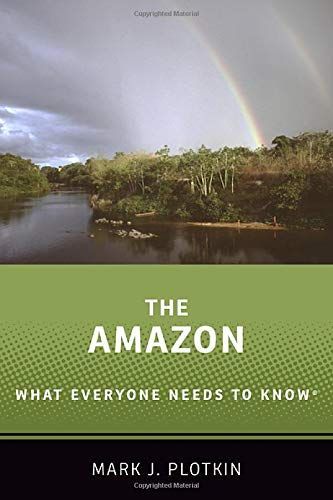
The Amazon What Everyone Needs to Know
"Rainforests occupy a special place in the imagination. Literary, historical and cinematic depictions range from a ghastly Green Hell to an idyllic Garden of Eden. In terms of fiction, they fired the already fervent imaginations of storytellers as diverse as Sir Arthur Conan Doyle, Edgar Rice Burroughs, Rudyard Kipling and even George Lucas and Steven Spielberg in whose books and films they are inhabited by dinosaurs, trod by Indiana Jones, prowled by Mowgli the Jungle Boy and swung through by Tarzan of the Apes. But rainforest fact is no less fascinating than rainforest fiction. Brimming with mystery and intrigue, these forests still harbor lost cities, uncontacted tribes, ancient shamans, and powerful plants than can kill - and cure. The rainforest bestiary extends far beyond the requisite lions, tigers and bears. Flying foxes and winged lizards, arboreal anteaters, rainforest giraffes, cross-dressing spiders that disguise themselves as ants and bats the size of a bumblebees all flourish in these most fabulous of forests along with other zoological denizens that are equally bizarre and spectacular. And no scientist immersed in these ecosystems believes that all the wonders have been found or revealed. Tropical rainforests merit their moniker. They flourish in the tropics - the more than 3000 mile-wide equatorial band between the Tropic of Cancer and the Tropic of Capricorn. And these forests are hot, humid and wet, receiving in the Amazon, on average from 60 to 120 inches of rain per year - as compared to a mere 25 inches in London or 45 inches in Manhattan. However, several sites in the rainforests of northeastern India, of west Africa and western Colombia are drenched by over 400 inches of precipitation per annum. To a large degree, rainfall in the tropics is determined by the so-called "Intertropical Convergence Zone" (ICZ), a band of clouds around the equator created by the meeting of the northeast and southeast trade winds. Also referred to as the "Monsoon Trough," and known to - and dreaded by - sailors over the centuries as the "Doldrums," since the extended periods of calm that sometimes manifested there could strand a sailing vessel for weeks. The constant cloud cover due to the ICZ, the ferocious heat, and the abundant rainfall combine to produce high humidity, sometimes close to 95 per cent in the Amazon, a challenge for visitors unused to such torpor. According to Rhett Butler of Mongabay: "Each canopy tree transpires 200 gallons of water annually, translating roughly into 20,000 gallons transpired into the atmosphere for every acre of canopy trees. Large rainforests (and their humidity) contribute to the formation of rain clouds, and generate as much as 75 per cent of their own rain and are therefore responsible for creating as much as 50 per cent of their own precipitation.""--